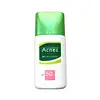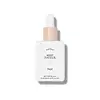Acnes UV Tint Milk Sunscreen SPF50+ PA++ Versus Agent Nateur Holi (Sun) Dewy Tinted Skin Drops SPF 50
What's inside
What's inside
 Key Ingredients
Key Ingredients

 Benefits
Benefits

 Concerns
Concerns

 Ingredients Side-by-side
Ingredients Side-by-side

Cyclopentasiloxane
EmollientWater
Skin ConditioningGlycereth-18 Ethylhexanoate
Skin ConditioningZinc Oxide
Cosmetic ColorantPhthalic Anhydride
PEG-8 Dimethicone
EmulsifyingTitanium Dioxide
Cosmetic ColorantTalc
AbrasiveMica
Cosmetic ColorantAluminum Hydroxide
EmollientDimethicone
EmollientButylene Glycol
HumectantGlycerin
HumectantTrimethylsiloxysilicate
EmollientCetyl PEG/PPG-10/1 Dimethicone
EmulsifyingVinyldimethicone
Dimethicone/Silsesquioxane Copolymer
CI 77492
Cosmetic ColorantO-Cymen-5-Ol
AntimicrobialTocopheryl Acetate
AntioxidantRosmarinus Officinalis Extract
AntimicrobialStearyl Glycyrrhetinate
Skin ConditioningMagnesium Sulfate
Parfum
MaskingCI 77491
Cosmetic ColorantCI 77499
Cosmetic ColorantPyridoxine Hcl
Skin ConditioningMagnesium Ascorbyl Phosphate
AntioxidantCyclopentasiloxane, Water, Glycereth-18 Ethylhexanoate, Zinc Oxide, Phthalic Anhydride, PEG-8 Dimethicone, Titanium Dioxide, Talc, Mica, Aluminum Hydroxide, Dimethicone, Butylene Glycol, Glycerin, Trimethylsiloxysilicate, Cetyl PEG/PPG-10/1 Dimethicone, Vinyldimethicone, Dimethicone/Silsesquioxane Copolymer, CI 77492, O-Cymen-5-Ol, Tocopheryl Acetate, Rosmarinus Officinalis Extract, Stearyl Glycyrrhetinate, Magnesium Sulfate, Parfum, CI 77491, CI 77499, Pyridoxine Hcl, Magnesium Ascorbyl Phosphate
Zinc Oxide 12%
Cosmetic ColorantWater
Skin ConditioningC12-15 Alkyl Benzoate
AntimicrobialCaprylic/Capric Triglyceride
MaskingJojoba Esters
EmollientPolyglyceryl-4 Diisostearate/Polyhydroxystearate/Sebacate
EmulsifyingPropanediol
SolventTridecyl Salicylate
Skin ConditioningNiacinamide
SmoothingNylon-12
Methylpropanediol
SolventSilica
AbrasiveCoco-Caprylate
EmollientPolyglyceryl-2 Dipolyhydroxystearate
Skin ConditioningSodium Chloride
MaskingCaprylyl Glycol
EmollientCarthamus Tinctorius Seed Oil
MaskingBisabolol
MaskingAllantoin
Skin ConditioningOryza Sativa Bran Extract
Skin ConditioningLecithin
EmollientStearalkonium Hectorite
Gel FormingPolyglyceryl-3 Diisostearate
EmulsifyingPolyglyceryl-3 Polyricinoleate
EmulsifyingPhenylpropanol
MaskingIron Oxides
Helianthus Annuus Extract
EmollientCitrus Aurantium Bergamia Fruit Oil
MaskingSalvia Triloba Leaf Extract
AntimicrobialTocopherol
AntioxidantSalvia Officinalis Leaf Extract
CleansingRosmarinus Officinalis Leaf Extract
AntimicrobialTetrasodium Glutamate Diacetate
Jasminum Officinale Flower/Leaf Extract
MaskingLavandula Angustifolia Flower/Leaf/Stem Extract
MaskingRutin
AntioxidantPelargonium Graveolens Extract
MaskingLinalool
PerfumingLimonene
PerfumingHydrogenated Lecithin
EmulsifyingSodium Hydroxide
BufferingZinc Oxide 12%, Water, C12-15 Alkyl Benzoate, Caprylic/Capric Triglyceride, Jojoba Esters, Polyglyceryl-4 Diisostearate/Polyhydroxystearate/Sebacate, Propanediol, Tridecyl Salicylate, Niacinamide, Nylon-12, Methylpropanediol, Silica, Coco-Caprylate, Polyglyceryl-2 Dipolyhydroxystearate, Sodium Chloride, Caprylyl Glycol, Carthamus Tinctorius Seed Oil, Bisabolol, Allantoin, Oryza Sativa Bran Extract, Lecithin, Stearalkonium Hectorite, Polyglyceryl-3 Diisostearate, Polyglyceryl-3 Polyricinoleate, Phenylpropanol, Iron Oxides, Helianthus Annuus Extract, Citrus Aurantium Bergamia Fruit Oil, Salvia Triloba Leaf Extract, Tocopherol, Salvia Officinalis Leaf Extract, Rosmarinus Officinalis Leaf Extract, Tetrasodium Glutamate Diacetate, Jasminum Officinale Flower/Leaf Extract, Lavandula Angustifolia Flower/Leaf/Stem Extract, Rutin, Pelargonium Graveolens Extract, Linalool, Limonene, Hydrogenated Lecithin, Sodium Hydroxide
Ingredients Explained
These ingredients are found in both products.
Ingredients higher up in an ingredient list are typically present in a larger amount.
Water. It's the most common cosmetic ingredient of all. You'll usually see it at the top of ingredient lists, meaning that it makes up the largest part of the product.
So why is it so popular? Water most often acts as a solvent - this means that it helps dissolve other ingredients into the formulation.
You'll also recognize water as that liquid we all need to stay alive. If you see this, drink a glass of water. Stay hydrated!
Learn more about WaterZinc Oxide is a mineral broad-spectrum UV filter; it is the broadest UVA and UVB reflector approved by the FDA. It also has skin protectant and skin soothing properties.
Zinc oxide is one of the most effective broad-spectrum UV filters. It protects against UVB, UVAII, and UVAI. In comparison to its counterpart titanium dioxide, zinc oxide provides uniform and extended UVA protection.
Another great benefit? This ingredient is highly photostable so it won't degrade easily under sunlight.
A common myth is that mineral UV filters are widely believed to primarily reflect UV light.
However, modern research shows titanium dioxide absorbs UV radiation like chemical filters (~95% absorption & 5% reflection).
Zinc oxide has great skin soothing properties so you'll likely find this in sunscreens formulated for sensitive skin or babies/children. It is unlikely to cause "eye sting" like other sunscreen ingredients.
Regulatory agencies consider zinc oxide to be non-toxic and safe. It has also been shown to not penetrate the skin.
Unfortunately, this ingredient does leave a visible white cast. This is why mineral sunscreens are often less cosmetically elegant than chemical or hybrid ones.
In cosmetics, zinc oxide can be found in both non-nano and nano-sized forms. The nano version is used to reduce white cast and improve the texture of sunscreen formulas.
There are ongoing concerns surrounding nano-zinc oxide's impact on marine ecosystems and whether it can be absorbed into skin.
Regarding marine ecosystems and coral reefs, there is no conclusive evidence that any form of zinc oxide (or any other sunscreen ingredients) will cause harm. The science is still developing but many consumers are keeping a close eye on this issue.
Please note, many destinations have reef-safety sunscreen rules. For instance, the U.S. Virgin Islands advises all visitors to use non-nano mineral sunscreens.
There has also been some stir about whether micronized or nano zinc oxide has potential photoxicity and absorption through the skin/lungs.
An in-vitro (done in a test tube or petri dish) study demonstrated micronized zinc oxide to have potential phototoxicity. There's no need to fret; the EU Commission's Scientific Committee on Consumer Safety has stated, "The relevance of these findings needs to be clarified by appropriate investigations in vivo." Or in other words, further studies done on living organisms are needed to prove this.
Current research shows zinc oxide nanoparticles do not penetrate intact or sunburned skin. They either remain on the surface or in the outermost layer of dead skin (stratum corneum).
Zinc oxide is one of only two classified mineral UV filters with titanium dioxide being the other one.
Fun fact: Zinc has been used throughout history as an ingredient in paint and medicine. An Indian text from 500BC is believed to list zinc oxide as a salve for open wound. The Ancient Greek physician Dioscorides has also mentioned the use of zinc as an ointment in 1AD.
Learn more about Zinc Oxide